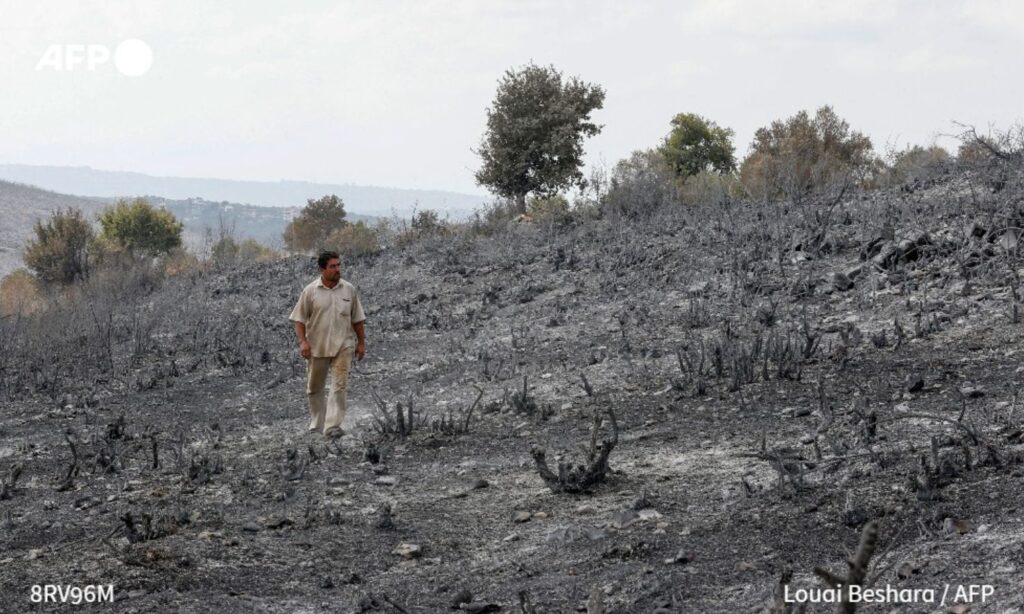The Ministry of Agriculture in the Syrian regime’s government clarified the number and size of the fires that occurred in the provinces of Homs, Latakia, and Tartus in recent days, mentioning that there are individuals who caused fires in Latakia.
The ministry reported on Sunday, November 3, that Latakia province witnessed 50 fires over the past four days, most of which were agricultural fires, some of which were out of control, such as the al-Mashrifa fire towards al-Badrousiya, the Burj Kas fire in Ma’irban, and the Mazir’ah fire.
Firefighting teams and locals were able to extinguish the fires in Latakia, except for some lingering hotspots towards the village of Samra, which were extinguished by the rain on Sunday, while the rain dampened the hotspots in Mazir’ah, Hiffa, and the countryside of Qardaha.
Latakia Governor Khaled Abaza stated in an interview with the local Sham FM radio that the first fire in Latakia was due to an electrical short circuit, but the fires at the beginning of November this year were “deliberate,” as was the case in 2020.
In a separate statement to the local Al-Watan newspaper, Abaza emphasized that “we will deal decisively and without any leniency if there are suspicions that individuals have deliberately ignited these fires,” as more than 30 fire hotspots coincided suddenly without prior warning.
The plurality of fire hotspots indicates that they are deliberately set, and an investigation is currently underway to confirm this, according to Abaza.
In October 2021, the Syrian Ministry of Justice announced the execution of 24 individuals accused of committing “terrorist acts” by setting fires, and also announced the punishment of 11 others with life imprisonment for damaging public and private properties.
These rulings were based on the provisions of the General Penal Code, the Code of Criminal Procedure, and the Anti-Terrorism Law No. 19 of 2012, according to the ministry.
Fires in Homs
According to the Director of Agriculture in Homs, Abdul Hadi al-Darwish, the area of land damaged by fires in Homs over the past ten days amounted to approximately 4,741 agricultural donums and 20 forest donums.
The largest fires in Homs occurred in the villages of Sheen, al-Meranah, and Jablaya on October 21, and the flames extended over an area of 375 donums, and the Wadi al-Nadara fire that broke out on the 27th and 28th of the same month affected 3,236 donums.
There was also a fire in the valley extending between the villages of Habnamra, Marmaritah, Ain al-Bardeh, Tannourin, and Qurb Ali in western Homs on October 28 and 29, covering an area of 1,130 donums.
The commander of the Homs Fire Brigade, Captain Iyad Muhammad, stated that the flames consumed vast areas of agricultural land, most of which was planted with olive trees.
The head of the municipality of Habnamra, Nizar Shabshoul, noted that 90% of the burned lands were planted with olive trees, and 10% were planted with fruitful trees such as figs and grapes, in addition to some oak shrubs.
Shabshoul added, “The villagers were significantly affected, especially since 75% of them had not yet harvested their olive crop from their lands.”
As for the fires in Tartus governorate, they were less damaging, totaling 26 fires that affected 34 donums.
Fire waves
Syria has witnessed waves of fires over the past three years in several provinces, including Latakia, Tartus, Homs, and Hama, with the fires of 2020 being the largest in Syria’s history, according to the Ministry of Agriculture.
The fires directly impacted residents of the villages where they broke out, in terms of losses in greenhouses and lands planted with fruit trees and crops, in addition to the burning of citizens’ properties.
The Syrian regime government repeatedly announces annual plans to combat fires and reduce their areas; however, the issue recurs every year, especially with the arrival of summer and rising temperatures.
In May, hundreds of hectares of agricultural land burned, mostly barley crops, in the villages and towns of Abu Jreis, Anq al-Hawa, and al-Shundakhiya, near Jab al-Jarah in the Homs countryside.

